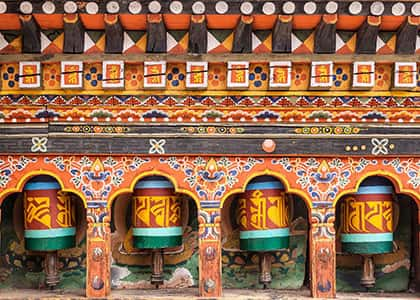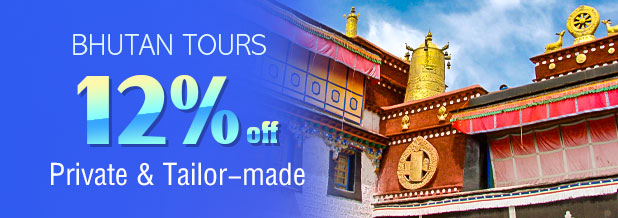Bhutan Travel Guide

|
Location: South Asia
Area: 14,824 sq mi (38,394 sq km)
Population: about 0.8 million
Language: Dzongkha and English
Currency: Ngultrum
Time Zone: UTC+6
Capital: Thimphu
Administrative Division: 4 Districts and 20 Dzongs (Counties)
Religions and Beliefs: Tibetan Buddhism and Hinduism
Top Things to Do in Bhutan
Bhutan is one of the happiest countries in the world, which is a mysterious place hidden in the mist over the Himalayas. When visiting the country, you will be astonished by its rich religious culture, where ancient temples, flying prayer flags, rotating prayer wheels and exquisite religious totem patterns are everywhere. Temples and Buddhist relics are highlights of the country; moreover, idyllic scenery is also unmissable. Postage stamps issued by Bhutan enjoy a good reputation in the world, especially unique CD and 3D stamps, and tourists can customize an exclusive postage stamp. In addition, it is an ideal place for trekking.
Top Destinations & Attractions:
Thimphu: Simtokha Dzong, Trashi Chhoe Dzong, Thimphu Takin Zoo
Paro: Taktshang Temple, Rinpung Dzong/Paro Dzong
Bumthang: Jambey Lhakhang, Mebar Tsho
Punakha: Punakha Dzong, Phobjikha Valley, Khamsum Yuelley Namgyel Chorten
|
|
|
Best Time to Visit Bhutan
Generally March to June and September to November are the best time to visit Bhutan as the weather is the most comfortable in a year with mild temperature and little rain. It is also suitable for hiking thanks to the clean air and beautiful scenery; furthermore, many festival celebrations are held during this period. Rainfall is mainly concentrated in August, and sometimes it rains for days, so you should avoid visiting there in August.
Read More: Bhutan Weather, Thimphu Weather
Transportation
Bhutan is a landlocked country, where highway dominates the transportation system. In some mountain area, horses, cows and mules are the main means of transport. Paro Airport is the only international airport, which operates flights to India, Bangladesh, Thailand and Vietnam. There are no railway and subway in the country, thus buses and taxis are the most convenient vehicles. Renting a car or a bicycle is also a good choice.
Bhutan Travel Tips
Bhutan imposes special restrictions on tourism, such as specifying minimum daily consumption standard and forbidding independent travel. All tourist visas must be applied and arranged by local travel agencies. Before traveling there, you should get in touch with a Bhutanese travel agency to obtain the tourist visa. As all Bhutanese are religious believers, religion plays an important role in their social life. Tourists must respect the local culture and custom. Taking off your shoes and hat before entering temples and do not point your fingers directly at the Buddha. The locals have strong environmental protection consciousness, so you should pay attention to your behaviors. Don't forget to take rain gear, if you want to visit in rainy season.
History
The earlier history of Bhutan is unclear due to lack of records. In the 8th century, it was a tribe of Tibetan regime in ancient China and became an independent tribe in the 9th century. It was invaded by Britain in 1772 and established the kingdom in 1907. Jigme Dorji Wangchuck, the third King, who established the country's assembly and prompted the United Nations to accept the country, is known as the father of Bhutan's modernization. The National Memorial Chorten was built in his honor, which becomes an attraction now. It is the only country which regards Tibetan Buddhism as national religion in the world. Its history and culture are deeply affected by religion. Simtokha Dzong is a famous religious and historical relic.
Geographical Features
Located on the southern slope of the eastern Himalayas, Bhutan is an inland country. It is divided into three physiographic regions, namely alpine, river valley and hilly and plain regions from the north to the south. Because of the special topographic features, snow mountains, grassland, forest, rivers and farmlands can come into your sight at the same time. It is a mountainous country, and the natural landscape of northern mountain area is charming, especially incomparable in Bumthang. The scenery of Dochu La Pass and Phojikha Valley formed by glacial erosion is also attractive.


